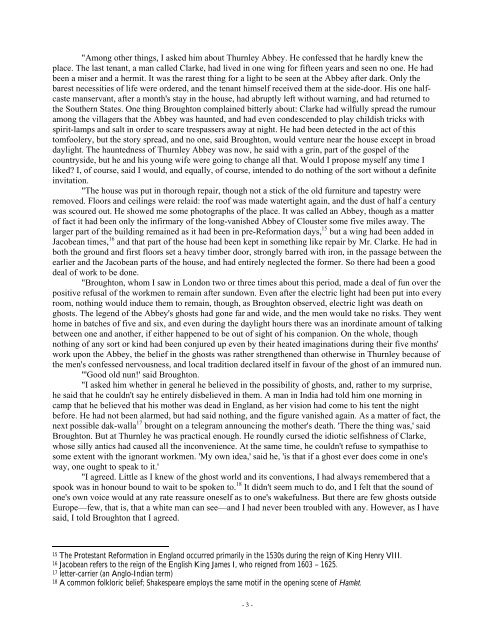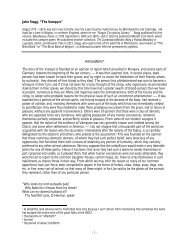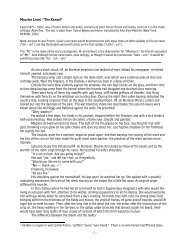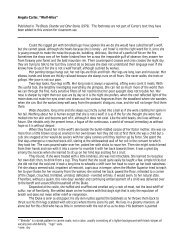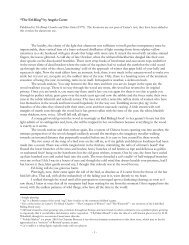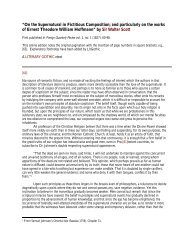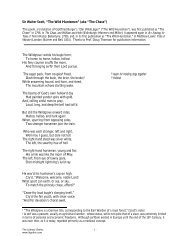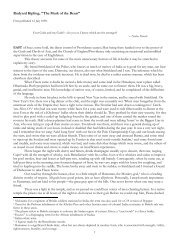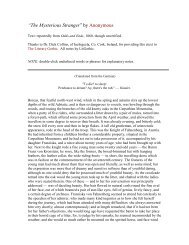“Thurnley Abbey” by Perceval Landon - The Literary Gothic
“Thurnley Abbey” by Perceval Landon - The Literary Gothic
“Thurnley Abbey” by Perceval Landon - The Literary Gothic
You also want an ePaper? Increase the reach of your titles
YUMPU automatically turns print PDFs into web optimized ePapers that Google loves.
"Among other things, I asked him about Thurnley Abbey. He confessed that he hardly knew the<br />
place. <strong>The</strong> last tenant, a man called Clarke, had lived in one wing for fifteen years and seen no one. He had<br />
been a miser and a hermit. It was the rarest thing for a light to be seen at the Abbey after dark. Only the<br />
barest necessities of life were ordered, and the tenant himself received them at the side-door. His one halfcaste<br />
manservant, after a month's stay in the house, had abruptly left without warning, and had returned to<br />
the Southern States. One thing Broughton complained bitterly about: Clarke had wilfully spread the rumour<br />
among the villagers that the Abbey was haunted, and had even condescended to play childish tricks with<br />
spirit-lamps and salt in order to scare trespassers away at night. He had been detected in the act of this<br />
tomfoolery, but the story spread, and no one, said Broughton, would venture near the house except in broad<br />
daylight. <strong>The</strong> hauntedness of Thurnley Abbey was now, he said with a grin, part of the gospel of the<br />
countryside, but he and his young wife were going to change all that. Would I propose myself any time I<br />
liked? I, of course, said I would, and equally, of course, intended to do nothing of the sort without a definite<br />
invitation.<br />
"<strong>The</strong> house was put in thorough repair, though not a stick of the old furniture and tapestry were<br />
removed. Floors and ceilings were relaid: the roof was made watertight again, and the dust of half a century<br />
was scoured out. He showed me some photographs of the place. It was called an Abbey, though as a matter<br />
of fact it had been only the infirmary of the long-vanished Abbey of Clouster some five miles away. <strong>The</strong><br />
larger part of the building remained as it had been in pre-Reformation days, 15 but a wing had been added in<br />
Jacobean times, 16 and that part of the house had been kept in something like repair <strong>by</strong> Mr. Clarke. He had in<br />
both the ground and first floors set a heavy timber door, strongly barred with iron, in the passage between the<br />
earlier and the Jacobean parts of the house, and had entirely neglected the former. So there had been a good<br />
deal of work to be done.<br />
"Broughton, whom I saw in London two or three times about this period, made a deal of fun over the<br />
positive refusal of the workmen to remain after sundown. Even after the electric light had been put into every<br />
room, nothing would induce them to remain, though, as Broughton observed, electric light was death on<br />
ghosts. <strong>The</strong> legend of the Abbey's ghosts had gone far and wide, and the men would take no risks. <strong>The</strong>y went<br />
home in batches of five and six, and even during the daylight hours there was an inordinate amount of talking<br />
between one and another, if either happened to be out of sight of his companion. On the whole, though<br />
nothing of any sort or kind had been conjured up even <strong>by</strong> their heated imaginations during their five months'<br />
work upon the Abbey, the belief in the ghosts was rather strengthened than otherwise in Thurnley because of<br />
the men's confessed nervousness, and local tradition declared itself in favour of the ghost of an immured nun.<br />
"'Good old nun!' said Broughton.<br />
"I asked him whether in general he believed in the possibility of ghosts, and, rather to my surprise,<br />
he said that he couldn't say he entirely disbelieved in them. A man in India had told him one morning in<br />
camp that he believed that his mother was dead in England, as her vision had come to his tent the night<br />
before. He had not been alarmed, but had said nothing, and the figure vanished again. As a matter of fact, the<br />
next possible dak-walla 17 brought on a telegram announcing the mother's death. '<strong>The</strong>re the thing was,' said<br />
Broughton. But at Thurnley he was practical enough. He roundly cursed the idiotic selfishness of Clarke,<br />
whose silly antics had caused all the inconvenience. At the same time, he couldn't refuse to sympathise to<br />
some extent with the ignorant workmen. 'My own idea,' said he, 'is that if a ghost ever does come in one's<br />
way, one ought to speak to it.'<br />
"I agreed. Little as I knew of the ghost world and its conventions, I had always remembered that a<br />
spook was in honour bound to wait to be spoken to. 18 It didn't seem much to do, and I felt that the sound of<br />
one's own voice would at any rate reassure oneself as to one's wakefulness. But there are few ghosts outside<br />
Europe—few, that is, that a white man can see—and I had never been troubled with any. However, as I have<br />
said, I told Broughton that I agreed.<br />
15 <strong>The</strong> Protestant Reformation in England occurred primarily in the 1530s during the reign of King Henry VIII.<br />
16 Jacobean refers to the reign of the English King James I, who reigned from 1603 – 1625.<br />
17 letter-carrier (an Anglo-Indian term)<br />
18 A common folkloric belief; Shakespeare employs the same motif in the opening scene of Hamlet.<br />
- 3 -


